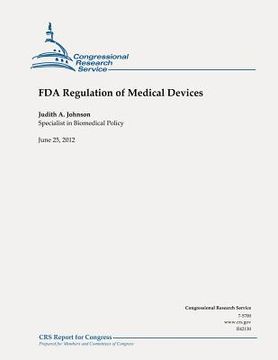Reseña del libro "FDA Regulation of Medical Devices (en Inglés)"
On June 20, 2012, the House of Representatives passed, by voice vote and under suspension of the rules, S. 3187 (EAH), the Food and Drug Administration Safety and Innovation Act, as amended. This bill would reauthorize the FDA prescription drug and medical device user fee programs (which would otherwise expire on September 30, 2012), create new user fee programs for generic and biosimilar drug approvals, and make other revisions to other FDA drug and device approval processes. It reflects bicameral compromise on earlier versions of the bill (S. 3187 [ES], which passed the Senate on May 24, 2012, and H.R. 5651 [EH], which passed the House on May 30, 2012). The following CRS reports provide overview information on FDA's processes for approval and regulation of drugs: CRS Report R41983, How FDA Approves Drugs and Regulates Their Safety and Effectiveness, by Susan Thaul; CRS Report RL33986, FDA's Authority to Ensure That Drugs Prescribed to Children Are Safe and Effective, by Susan Thaul; CRS Report R42130, FDA Regulation of Medical Devices, by Judith A. Johnson; CRS Report R42508, The FDA Medical Device User Fee Program, by Judith A. Johnson. (Note: The rest of this report has not been updated since December 28, 2011.) Prior to and since the passage of the Medical Device Amendments of 1976, Congress has debated how best to ensure that consumers have access, as quickly as possible, to new and improved medical devices and, at the same time, prevent devices that are not safe and effective from entering or remaining on the market. Medical devices regulation is complex, in part, because of the wide variety of items that are categorized as medical devices; examples range from a simple tongue depressor to a life-sustaining heart valve. The regulation of medical devices can affect their cost, quality, and availability in the health care system. In order to be legally marketed in the United States, many medical devices must be reviewed by the Food and Drug Administration (FDA), the agency responsible for protecting the public health by overseeing medical products, including devices. FDA's Center for Devices and Radiological Health (CDRH) is primarily responsible for medical device review. CDRH activities are funded through a combination of public money (i.e., direct FDA appropriations from Congress) and private money (i.e., user fees collected from device manufacturers) which together comprise FDA's total. User fees account for 33% of FDA's total FY2011 program level and 15% of CDRH's program level, which is $378 million in FY2011 including $56 million in user fees. FDA's authority to collect user fees, originally authorized in 2002 (P.L. 107-250), has been reauthorized in five-year increments. It will expire on October 1, 2012, under the terms of the Medical Device User Fee Act of 2007 (MDUFA), Title II of the FDA Amendments Act of 2007 (FDAAA, P.L. 110-85). FDA requires all medical product manufacturers to register their facilities, list their devices with FDA, and follow general controls requirements. FDA classifies devices according to the risk they pose to consumers. Premarket review is required for moderate- and high-risk devices. There are two paths that manufacturers can use to bring such devices to market. One path consists of conducting clinical studies, submitting a premarket approval (PMA) application and requires evidence providing reasonable assurance that the device is safe and effective. The other path involves submitting a 510(k) notification demonstrating that the device is substantially equivalent to a device already on the market (a predicate device) that does not require a PMA. The 510(k) process results in FDA clearance and tends to be much less expensive and less time- consuming than seeking FDA approval via PMA.

